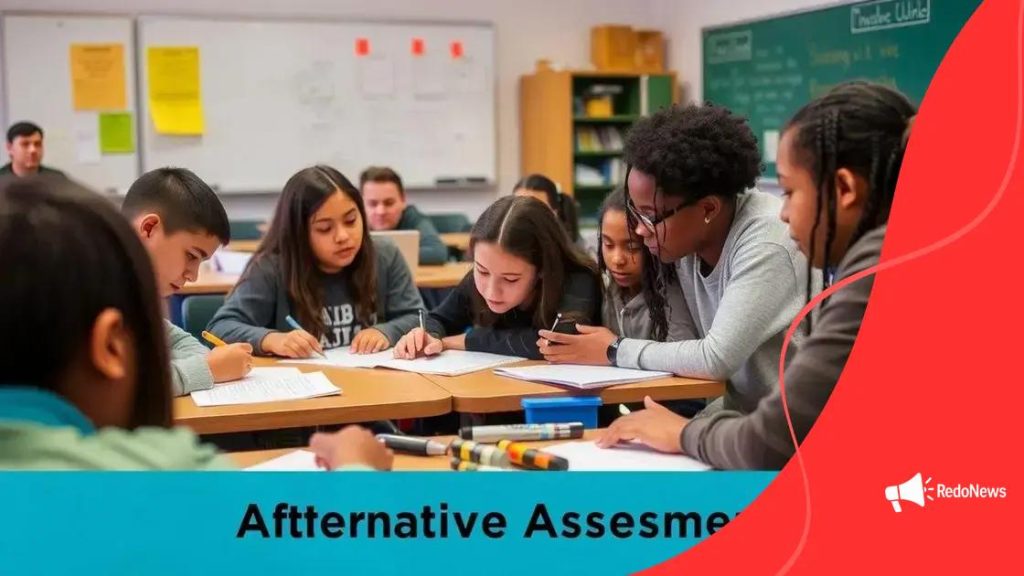Standardized tests: alternatives worth exploring

Rethinking grading with pass/fail systems reduces student stress, emphasizes mastery, and encourages collaboration, transforming how assessments promote learning and understanding in educational environments.
Standardized tests: alternatives seen are becoming an important topic in education. Have you considered how these alternatives might impact student learning and equity? Let’s explore.
Understanding the limitations of standardized tests
Understanding standardized tests is essential in today’s educational landscape. While these tests aim to measure knowledge and skills, they often come with significant limitations that can affect student outcomes and equity.
One major limitation is their narrow focus. Standardized tests typically emphasize specific subjects and formats, which can overlook critical skills such as creativity and critical thinking. This narrow scope can disadvantage students who excel in areas not covered by these assessments.
Consequences of Reliance on Standardized Tests
The consequences of relying on standardized tests can be profound. For example, students may experience stress and anxiety, as their futures seem to hinge on a single performance. Additionally, teachers may feel pressured to ‘teach to the test’, which limits their ability to explore engaging and meaningful curricula.
Potential Bias in Testing
Standardized tests can also introduce bias. Factors such as socioeconomic status, language barriers, and cultural differences can affect performance, leading to unfair assessments of students’ abilities. This can perpetuate cycles of disadvantage for underrepresented groups.
- Limited assessment of real-world skills
- Increased stress for students
- Pressure on teachers to conform to testing standards
By understanding these limitations, educators and policymakers can begin to explore alternatives that provide a more holistic view of student learning. It is crucial to recognize the impact that these tests can have and to seek out solutions that promote equity and support diverse learners without the constraints of standardized measures.
Alternative assessment methods in education
Alternative assessment methods in education offer a refreshing change from traditional standardized tests. These methods can focus on a broader range of skills and competencies, emphasizing student understanding and engagement.
One popular alternative is the use of portfolios. Portfolios allow students to showcase their work over time, providing a comprehensive view of their learning journey. They can include various forms of content like essays, projects, and art, reflecting their individual strengths and progress.
Benefits of Alternative Assessments
Alternative assessments can enhance the educational experience in several ways. They can:
- Encourage creativity and critical thinking
- Provide timely feedback to support learning
- Reduce anxiety often associated with testing
Beyond portfolios, project-based assessments present another effective method. In project-based learning, students engage in real-world challenges that require problem-solving and collaboration. This hands-on approach allows them to apply knowledge in a practical context.
Formative Assessments in the Classroom
Additionally, formative assessments play a crucial role in alternative evaluation. These assessments occur throughout the learning process and can include observations, quizzes, and classroom discussions. By consistently gathering information about student performance, teachers can adjust their instruction to better meet student needs.
Using a mix of assessment methods creates a more inclusive environment, catering to diverse learning styles. This not only helps to engage students but also fosters a deeper love for learning, enhancing overall educational outcomes.
Benefits of portfolio assessments

Portfolio assessments offer several benefits that enhance the educational experience for students. They allow for a more personalized approach to evaluating a student’s abilities and learning progress.
One key advantage of portfolio assessments is that they provide a comprehensive view of a student’s work over time. This approach not only showcases their achievements but also highlights areas for improvement. Teachers can see how a student’s skills develop, enabling tailored feedback and support.
Encouraging Self-Reflection
Portfolios encourage self-reflection among students. As they gather their work, students often take time to think about their learning experiences, challenges, and successes. This process fosters a deeper understanding of their educational journey and helps them set future goals.
Diverse Skill Demonstration
Another benefit is that portfolio assessments can demonstrate a variety of skills. Unlike traditional tests that focus on specific subjects, portfolios can include essays, projects, artwork, and even videos. This diversity allows students to present their strengths and showcase their creativity in ways that standardized tests cannot.
- Promotes individual learning paths
- Encourages collaboration through group projects
- Reduces test anxiety by providing multiple evaluation formats
In addition, working on portfolios can enhance critical thinking and problem-solving skills. Students learn to make decisions about what to include, how to present their work, and how to communicate their thoughts effectively. These skills are essential not only in academics but also in real-world situations.
How formative assessments can reshape learning
Formative assessments are powerful tools that can reshape learning in significant ways. These assessments happen regularly throughout the learning process and aim to provide feedback to both teachers and students.
One major benefit of formative assessments is that they help identify student strengths and weaknesses promptly. By gathering information during the learning process, teachers can adjust their instruction based on students’ needs, leading to improved learning outcomes.
Engaging Students in Their Learning
Formative assessments also engage students more actively in their own learning. When students receive immediate feedback, they can identify areas that need improvement and work towards their goals. This ongoing dialogue fosters a growth mindset, encouraging them to take ownership of their education.
Varied Assessment Methods
Another advantage is the variety of methods used in formative assessments. Teachers can employ quizzes, discussions, peer reviews, and observational notes. This diverse range of strategies caters to different learning styles, making assessments more inclusive.
- Encourages continuous improvement
- Promotes collaboration among students
- Provides opportunities for self-assessment
Additionally, formative assessments reduce the stress often linked to traditional testing. Since these assessments are more informal, students can focus on learning rather than merely achieving a grade. This positive environment allows for deeper exploration of subjects, leading to a more meaningful education.
In a setting where formative assessments are integrated, the overall classroom dynamic shifts. Teachers become facilitators of learning, guiding discussions and helping students navigate challenges. This collaborative atmosphere nurtures critical thinking and creativity, essential skills for success in life.
Rethinking grading: pass/fail systems
Rethinking grading through pass/fail systems can transform the way we assess students. This approach eliminates traditional letter grades, focusing instead on whether a student has achieved sufficient understanding of the material.
One major benefit of a pass/fail system is that it reduces stress and anxiety among students. Rather than worrying about achieving a specific grade, students can concentrate on mastering skills and knowledge at their own pace. This shift allows for a more positive learning environment that encourages exploration and creativity.
Emphasizing Mastery Over Numbers
In a pass/fail system, the emphasis is on mastery rather than competition. This reduces the pressure to compare oneself with peers, fostering a collaborative learning atmosphere. Students support one another in achieving learning goals, rather than competing for high grades.
Flexibility in Learning
Another advantage is that pass/fail systems allow for greater flexibility. Students can take risks in their learning without the fear of harsh penalties for failure. This environment encourages experimentation and innovation, which are essential in today’s fast-changing world.
- Reduces grade-induced stress
- Encourages focus on learning outcomes
- Promotes supportive learning communities
While rethinking grading, it’s important to maintain a system that still holds students accountable for their learning. Clear expectations and outcomes should be established to ensure that all students understand what is needed to pass. This clarity helps maintain educational integrity while fostering a culture of learning.
Although some may argue that pass/fail systems may not provide enough detail about a student’s performance, they can actually promote a deeper understanding of individual growth. Teachers can offer meaningful feedback that guides students in their learning process without the limitations of traditional grading.
FAQ – Common Questions about Rethinking Grading with Pass/Fail Systems
What are the benefits of a pass/fail grading system?
A pass/fail system reduces stress, emphasizes mastery over competition, and encourages collaboration among students.
How does pass/fail grading affect student motivation?
It helps students focus more on learning and understanding concepts, rather than worrying about achieving high letter grades.
Can pass/fail systems still hold students accountable?
Yes, clear expectations can be set to ensure students know what is required to pass, maintaining educational integrity.
What types of assessments can be used in a pass/fail system?
Teachers can use various assessments like projects, portfolios, and participation to evaluate students in a more comprehensive manner.
